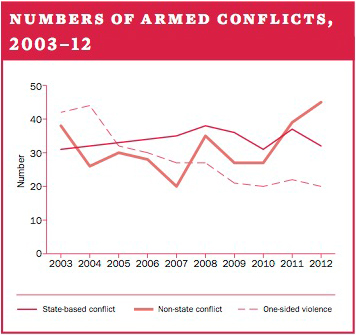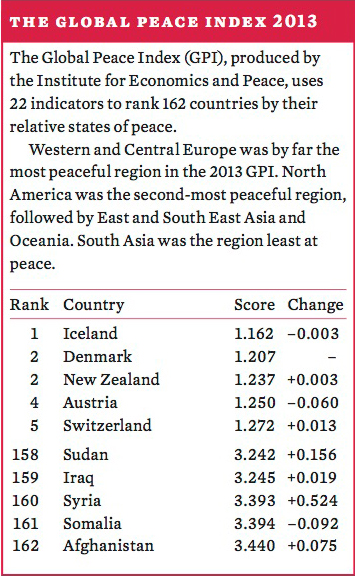2. Armed conflict
Contents
- Overview
NEIL MELVIN
- I. Mediation and peace agreements [PDF]
ISAK SVENSSON AND MAGNUS LUNDGREN
- II. The United Nations Security Council in state-based armed conflicts, 2003–12 [PDF]
PETER WALLENSTEEN AND PATRIK JOHANSSON
- III. Patterns of organized violence, 2003–12 [PDF]
LOTTA THEMNÉR AND PETER WALLENSTEEN*
- IV. The Global Peace Index 2013 [PDF]
CAMILLA SCHIPPA AND DANIEL HYSLOP**
* Uppsala Conflict Data Program
** Institute for Economics and Peace
Summary
In recent years there has been an upward trend in fatalities caused by state-based conflicts. Some regions of the world, notably the Middle East, have experienced significant rises in the number of battle-related deaths. There has also been a rise in internationalized intrastate conflicts. These developments suggest a worrying upward trend in lethal violence related to state-based conflicts.
In the post-cold war period, a leading response of the international community to armed conflict involving states—particularly with regional or global security dimensions (and especially international terrorism)—has been to launch interventions often involving the use of military force. In 2013 there were indications that the use of force as a means to address conflict and terrorist challenges was increasingly viewed by many in the Western community as being of limited utility and as being too costly in terms of money, lives lost and political capital expended.
Allegations of the use of chemical weapons in an attack in Damascus on 21 August 2013 triggered a substantial international debate about a military response to the civil war in Syria. There was also widespread concern about the ongoing large-scale loss of life in Syria, reports that the conflict was serving as an incubator for violent jihadi groups and indications of a growing risk of a wider regional destabilization.
Initially, the USA and key European allies seemed to be preparing for military strikes in Syria. Following a parliamentary vote in the United Kingdom against the use of force in Syria, and concern that the US Congress might also vote against action, the US administration opted to pursue a diplomatic response to the chemical weapon issue and refrained from military intervention. This was widely viewed as marking a turning point in Western policy towards a far more limited military involvement in conflicts around the world.
Mediation and peace agreements
Mediation offers an important means to resolve armed conflicts. Over recent decades, traditional diplomatic approaches have been supplemented by the emergence of a myriad of non-state actors involved in mediation and ‘track 2’ diplomacy. As a result of these efforts, a significant number of armed conflicts have been brought to resolution through mediation, often leading to a peace agreement. In recent years, however, there has been a notable decline in the number of peace agreements. This raises concerns that there may be important limits on the use of mediation as an alternative to military intervention to end conflicts, without a considerable new investment in peacemaking efforts.
The United Nations Security Council in state-based armed conflicts
In a situation of declining direct military intervention in response to conflict by the Western powers, the United Nations could take on increased responsibilities as a conflict prevention and resolution mechanism. The UN Security Council’s key tools for addressing conflicts include resolutions passed under chapters VI and VII of the UN Charter. The number of such resolutions provides a useful measure of the attention that the Council pays to state-based armed conflicts. It shows a great variation in this type of attention, which can be attributed to the length and intensity of the conflict, the conflict’s location, and how it is perceived to affect the interests of any permanent member of the Council.
Numbers of conflicts, 2003–12

Patterns of organized violence, 2003–12
The Uppsala Conflict Data Program (UCDP) maps organized violence around the world according to three categories of violent action: state-based conflict, non-state conflict and one-sided violence.
The number of incidents of violent action that resulted in the deaths of more than 25 people in a particular year (UCDP’s threshold for counting) was slightly lower in 2012, at 97, than in 2003, when it stood at 111. While the number of state-based and non-state conflicts had increased over the decade, the number of incidences of one-sided violence declined continuously.
Looking at the overall trend in the number of fatalities in organized violence, a more negative picture emerges. Largely due to developments in state-based conflict, the number of deaths from organized violence increased from almost 36 000 in 2003 to nearly 46 000 in 2012.
Within the overall trend, each of the three types of violence has its own internal dynamics, only partially affected by the other forms. The full picture is more complex, but there is no clear indication that the three types of violence offset each other, for instance, with a decline in one type leading to an increase in the other two.
The Global Peace Index 2013
